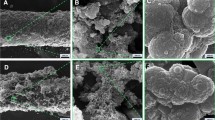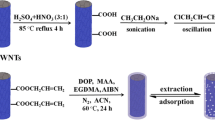Abstract
Bisphenol A (BPA), known for its endocrine-disrupting properties and potential to leach into food products, has led to significant food safety concerns. Therefore, the development of sensitive and selective BPA rapid detection methods is crucial. In this study, molecularly imprinted solid-phase extraction coupled to a colorimetric method was adopted for the smartphone-based determination of BPA. The molecularly imprinted polymer (MIP) was prepared via photopolymerization and used as a selective adsorbent material for SPE columns. The solid-phase extraction (SPE) columns with multiple cycles significantly reduced the extraction time to only 30 min. The developed method demonstrates useful sensitivity for BPA (LOD = 30 ppb). Furthermore, BPA migration from plastic packaging was evaluated under different storage conditions, revealing that microwave treatment for 5 min led to BPA release from polycarbonate packaging in juice and basic solutions. The MIP selective extraction/clean-up and smartphone-based optical sensor were successfully applied to BPA standard solutions and complex food samples (e.g., juice and tap water), resulting in reproducible and selective BPA determination (RSD ≤ 6%, n = 3). This rapid and cost-effective method of producing MIPs for BPA offers a promising solution for fast and low-cost sensing for on-site fresh food analysis.
Graphical abstract










Similar content being viewed by others
References
Raysyan A, Zwigart SD, Eremin SA, Schneider RJ. BPA endocrine disruptor detection at the cutting edge: FPIA and ELISA immunoassays. Biosensors. 2023;13(6):664.
Michałowicz J. Bisphenol A – sources, toxicity and biotransformation. Environ Toxicol Pharmacol. 2014;37(2):738–58. https://doi.org/10.1016/j.etap.2014.02.003.
Prueitt RL, Hixon ML, Fan T, Olgun NS, Piatos P, Zhou J, Goodman JE. Systematic review of the potential carcinogenicity of bisphenol A in humans. Regul Toxicol Pharmacol. 2023;142:105414. https://doi.org/10.1016/j.yrtph.2023.105414.
Mukherjee U, Das S, Ghosh S, Maitra S (2024) Reproductive toxicity of bisphenol A, at environmentally relevant concentrations, on ovarian redox balance, maturational response, and intra-oocyte signalling events in Labeo bata. Sci Total Environ 906. https://doi.org/10.1016/j.scitotenv.2023.167415.
Santos JDS, Pontes MDS, de Souza MB, Fernandes SY, Azevedo RA, de Arruda GJ, Santiago EF (2023) Toxicity of bisphenol A (BPA) and its analogues BPF and BPS on the free-floating macrophyte Salvinia biloba. Chemosphere 343. https://doi.org/10.1016/j.chemosphere.2023.140235.
Ma Y, Liu H, Wu J, Yuan L, Wang Y, Du X, Wang R, Marwa PW, Petlulu P, Chen X. The adverse health effects of bisphenol A and related toxicity mechanisms. Environ Res. 2019;176:108575.
Han E, Pan Y, Li L, Cai J (2023) Bisphenol A detection based on nano gold-doped molecular imprinting electrochemical sensor with enhanced sensitivity. Food Chem 426. https://doi.org/10.1016/j.foodchem.2023.136608.
Liu SG, Wu T, Liang Z, Zhao Q, Gao W, Shi X (2023) A fluorescent method for bisphenol A detection based on enzymatic oxidation-mediated emission quenching of silicon nanoparticles. Spectrochim Acta - Part A: Mol Biomol Spectrosc 302. https://doi.org/10.1016/j.saa.2023.123123.
El Hani O, Karrat A, Digua K, Amine A (2023) Advanced molecularly imprinted polymer-based paper analytical device for selective and sensitive detection of Bisphenol-A in water samples. Microchemical Journal 184:108157
Zhu Y, Liang M, Liu Y, Zhong M, Zhou B, Huang L, Zhang Z. Magnetic metal–organic framework material synthesized by molecular imprinting technology for analysis of bisphenol A. Chromatographia. 2023;86(10):669–76. https://doi.org/10.1007/s10337-023-04277-w.
Karrat A, Amine A. Solid-phase extraction combined with a spectrophotometric method for determination of bisphenol-A in water samples using magnetic molecularly imprinted polymer. Microchem J. 2021;168:106496. https://doi.org/10.1016/j.microc.2021.106496.
Tsalbouris A, Kalogiouri NP, Kabir A, Furton KG, Samanidou VF (2021) Bisphenol A migration to alcoholic and non-alcoholic beverages – an improved molecular imprinted solid phase extraction method prior to detection with HPLC-DAD. Microchem J 162. https://doi.org/10.1016/j.microc.2020.105846.
Wu YT, Zhang YH, Zhang M, Liu F, Wan YC, Huang Z, Ye L, Zhou Q, Shi Y, Lu B. Selective and simultaneous determination of trace bisphenol A and tebuconazole in vegetable and juice samples by membrane-based molecularly imprinted solid-phase extraction and HPLC. Food Chem. 2014;164:527–35. https://doi.org/10.1016/j.foodchem.2014.05.071.
Yuan Y, Liu Y, Teng W, Tan J, Liang Y, Tang Y. Preparation of core-shell magnetic molecular imprinted polymer with binary monomer for the fast and selective extraction of bisphenol A from milk. J Chromatogr A. 2016;1462:2–7. https://doi.org/10.1016/j.chroma.2016.06.045.
Chang C-M, Chou C-C, Lee M-R. Determining leaching of bisphenol A from plastic containers by solid-phase microextraction and gas chromatography–mass spectrometry. Anal Chim Acta. 2005;539(1–2):41–7.
Lu J, Wu J, Stoffella PJ, Wilson PC. Analysis of bisphenol A, nonylphenol, and natural estrogens in vegetables and fruits using gas chromatography–tandem mass spectrometry. J Agric Food Chem. 2013;61(1):84–9.
Maragou NC, Lampi EN, Thomaidis NS, Koupparis MA. Determination of bisphenol A in milk by solid phase extraction and liquid chromatography–mass spectrometry. J Chromatogr A. 2006;1129(2):165–73.
Alenazi NA, Manthorpe JM, Lai EPC. Selective extraction of BPA in milk analysis by capillary electrophoresis using a chemically modified molecularly imprinted polymer. Food Control. 2015;50:778–83. https://doi.org/10.1016/j.foodcont.2014.10.026.
Beduk T, Ait Lahcen A, Tashkandi N, Salama KN. One-step electrosynthesized molecularly imprinted polymer on laser scribed graphene bisphenol a sensor. Sens Actuators, B Chem. 2020;314:128026. https://doi.org/10.1016/j.snb.2020.128026.
Jia M, Chen S, Shi T, Li C, Wang Y, Zhang H. Competitive plasmonic biomimetic enzyme-linked immunosorbent assay for sensitive detection of bisphenol A. Food Chem. 2021;344:128602. https://doi.org/10.1016/j.foodchem.2020.128602.
Elfadil D, Lamaoui A, Della Pelle F, Amine A, Compagnone D. Molecularly imprinted polymers combined with electrochemical sensors for food contaminants analysis. Molecules. 2021;26(15):4607.
Hasseb AA, Abdel Ghani NdT, Shehab OR, El Nashar RM. Application of molecularly imprinted polymers for electrochemical detection of some important biomedical markers and pathogens. Curr Opin Electrochem. 2022;31:100848. https://doi.org/10.1016/j.coelec.2021.100848.
Liu Y-H, Liu C, Wang X-H, Li T, Zhang X. Electrochemical sensor for sensitive detection of bisphenol A based on molecularly imprinted TiO2 with oxygen vacancy. Biosens Bioelectron. 2023;237:115520. https://doi.org/10.1016/j.bios.2023.115520.
Han L, Zhu X, Zhang D, Liu H, Sun B. Peptide-based molecularly imprinted polymer: a visual and digital platform for specific recognition and detection of ethyl carbamate. ACS Sensors. 2023;8(2):694–703. https://doi.org/10.1021/acssensors.2c02197.
Hassanzadeh M, Ghaemy M, Amininasab SM, Shami Z. Molecularly imprinted polymer capped near infrared fluorescent emitting Ag2S-functionalized-COOH quantum dots for detection of creatinine as a nanosensor with high sensitivity and selectivity. Sens Actuators, A. 2021;331:112936. https://doi.org/10.1016/j.sna.2021.112936.
Saylan Y, Erdem Ö, Inci F, Denizli A. Advances in biomimetic systems for molecular recognition and biosensing. Biomimetics (Basel). 2020;5(2):20.
Saylan Y, Denizli A. Chapter 1 - fundamentals and applications of molecularly imprinted systems. In: Denizli A, editor. Molecular Imprinting for Nanosensors and Other Sensing Applications. Elsevier; 2021. p. 1–17.
Inroga FAD, Rocha MO, Lavayen V, Arguello J. Development of a tyrosinase-based biosensor for bisphenol A detection using gold leaf–like microstructures. J Solid State Electrochem. 2019;23(6):1659–66. https://doi.org/10.1007/s10008-019-04252-2.
Lu H, Xu S. Visualizing BPA by molecularly imprinted ratiometric fluorescence sensor based on dual emission nanoparticles. Biosens Bioelectron. 2017;92:147–53. https://doi.org/10.1016/j.bios.2017.02.013.
Sinha A, Wu L, Lu X, Chen J, Jain R. Corrigendum to “Advances in sensing and biosensing of bisphenols: a review” [ACA 998 (2018) 1–27](S000326701731156X)(10.1016/j.aca.2017.09.048). Anal Chim Acta. 2018;1029:125–9. https://doi.org/10.1016/j.aca.2018.05.047.
Wang CY, Zeng Y, Shen AG, Hu JM. A highly sensitive SERS probe for bisphenol A detection based on functionalized Au@Ag nanoparticles. Anal Methods. 2018;10(47):5622–8. https://doi.org/10.1039/c8ay01966e.
Lach P, Garcia-Cruz A, Canfarotta F, Groves A, Kalecki J, Korol D, Borowicz P, Nikiforow K, Cieplak M, Kutner W, Piletsky SA, Sharma PS. Electroactive molecularly imprinted polymer nanoparticles for selective glyphosate determination. Biosens Bioelectron. 2023;236:115381. https://doi.org/10.1016/j.bios.2023.115381.
Ikegami T, Mukawa T, Nariai H, Takeuchi T. Bisphenol A-recognition polymers prepared by covalent molecular imprinting. Anal Chim Acta. 2004;504(1):131–5. https://doi.org/10.1016/j.aca.2003.08.032.
Goo SH, Velhal NB, Park J. Fabrication and evaluation of molecularly imprinted structured polymeric films via photopolymerization for bisphenol A detection. MRS Commun. 2021;11(5):576–83. https://doi.org/10.1557/s43579-021-00077-1.
Paruli E III, Soppera O, Haupt K, Gonzato C. Photopolymerization and photostructuring of molecularly imprinted polymers. ACS Appl Polym Mater. 2021;3(10):4769–90. https://doi.org/10.1021/acsapm.1c00661.
Elfadil D, Della Pelle F, Compagnone D, Amine A. Green synthesis of molecularly imprinted polymers for dispersive magnetic solid-phase extraction of erythrosine B associated with smartphone detection in food samples. Materials. 2022;15(21):7653.
Wang J, Shen Q, Yu X, Kang Q, Shen D. A smartphone-based ratiometric fluorescence and absorbance dual-mode device for rhodamine B determination in combination with differential molecularly imprinting strategy and primary inner filter effect correction. Microchem J. 2022;183:108077. https://doi.org/10.1016/j.microc.2022.108077.
Liu J, Zhan Y, Qiu B, Lin Z, Guo L. Portable smartphone platform based on aggregation-induced enhanced emission carbon dots for ratiometric quantitative sensing of fluoride ions. ACS Sensors. 2023;8(2):884–92. https://doi.org/10.1021/acssensors.2c02589.
Yang T, Luo Z, Bewal T, Li L, Xu Y, Mahdi Jafari S, Lin X. When smartphone enters food safety: a review in on-site analysis for foodborne pathogens using smartphone-assisted biosensors. Food Chem. 2022;394:133534. https://doi.org/10.1016/j.foodchem.2022.133534.
Palmieri S, Elfadil D, Fanti F, Della Pelle F, Sergi M, Amine A, Compagnone D. Study on molecularly imprinted polymers obtained sonochemically for the determination of aflatoxins in food. Molecules. 2023;28(2):703.
Elfadil D, Palmieri S, Della Pelle F, Sergi M, Amine A, Compagnone D. Enzyme inhibition coupled to molecularly imprinted polymers for acetazolamide determination in biological samples. Talanta. 2022;240:123195.
Lamaoui A, García-Guzmán JJ, Amine A, Palacios-Santander JM, Cubillana-Aguilera L (2021) Synthesis techniques of molecularly imprinted polymer composites. In: Molecularly Imprinted Polymer Composites. Elsevier, pp 49–91.
Elfadil D, Saidi K, Amine A. Selective extraction of maleic hydrazide in foods using magnetic molecularly imprinted polymers and colorimetric detection via smartphone. Talanta. 2024;269:125488.
Fuchs Y, Soppera O, Haupt K. Photopolymerization and photostructuring of molecularly imprinted polymers for sensor applications—a review. Anal Chim Acta. 2012;717:7–20. https://doi.org/10.1016/j.aca.2011.12.026.
Gallo P, Di Marco PI, Esposito F, Fasano E, Scognamiglio G, Mita GD, Cirillo T. Determination of BPA, BPB, BPF, BADGE and BFDGE in canned energy drinks by molecularly imprinted polymer cleaning up and UPLC with fluorescence detection. Food Chem. 2017;220:406–12. https://doi.org/10.1016/j.foodchem.2016.10.005.
Li J, Zhou H, Liu Y-X, Yan X-Y, Xu Y-P, Liu S-M. Solid-phase extraction for selective determination of bisphenol A in drinks and fruits by dummy surface molecularly imprinted polymer with direct synthetic method. Food Addit Contam: Part A. 2014;31(6):1139–46. https://doi.org/10.1080/19440049.2014.906751.
Huang X-C, Ma J-K, Wei S-L. Preparation and application of a novel magnetic molecularly imprinted polymer for simultaneous and rapid determination of three trace endocrine disrupting chemicals in lake water and milk samples. Anal Bioanal Chem. 2020;412(8):1835–46. https://doi.org/10.1007/s00216-020-02431-z.
Bhogal S, Mohiuddin I, Kaur K, Lee J, Brown RJC, Malik AK, Kim K-H. Dual-template magnetic molecularly imprinted polymer-based sorbent for simultaneous and selective detection of phenolic endocrine disrupting compounds in foodstuffs. Environ Pollut. 2021;275:116613. https://doi.org/10.1016/j.envpol.2021.116613.
Acknowledgements
The authors acknowledge the EU-PRIMA-FEDKITO project—Fresh food sustainable packaging in the circular economy.
Funding
This work was supported by EU-PRIMA-FEDKITO project—Fresh food sustainable packaging in the circular economy.
Author information
Authors and Affiliations
Contributions
Conceptualization; formal analysis; methodology; investigation; writing, original draft; and figure drawings: D.E. Conceptualization; supervision; visualization; reviewing and editing; validation; and project administration: A.A. All authors have read and agreed to the published version of the manuscript.
Corresponding author
Ethics declarations
Ethics approval
Not applicable.
Source of biological material
Not applicable.
Statement on animal welfare
Not applicable.
Conflict of interest
The authors declare no competing interests.
Additional information
Publisher's Note
Springer Nature remains neutral with regard to jurisdictional claims in published maps and institutional affiliations.
Supplementary Information
Below is the link to the electronic supplementary material.
Rights and permissions
Springer Nature or its licensor (e.g. a society or other partner) holds exclusive rights to this article under a publishing agreement with the author(s) or other rightsholder(s); author self-archiving of the accepted manuscript version of this article is solely governed by the terms of such publishing agreement and applicable law.
About this article
Cite this article
Elfadil, D., Amine, A. Molecularly imprinted photopolymers combined with smartphone-based optical sensing for selective detection of bisphenol A in foods. Anal Bioanal Chem 416, 2479–2492 (2024). https://doi.org/10.1007/s00216-024-05212-0
Received:
Revised:
Accepted:
Published:
Issue Date:
DOI: https://doi.org/10.1007/s00216-024-05212-0




